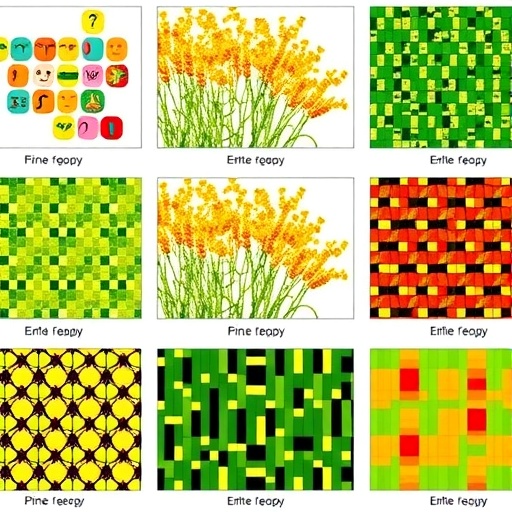In a groundbreaking study, Sunil Subramanya and his colleagues have unveiled significant insights into the world of microsatellites within cereal and legume species. Through a comparative genomics approach, this research sheds light on the differential distribution of these genetic structures, offering a fresh perspective on how they may influence the traits of various plant species. This work is particularly relevant in a world where food security is paramount, and understanding genetic variations is crucial for enhancing crop resilience and productivity.
Microsatellites, also known as short tandem repeats (STRs), are repetitive sequences of DNA that play a vital role in genetic diversity. Their variability can affect how plants respond to environmental stressors, which is increasingly important as climate change poses new challenges to agriculture. This study not only maps the distribution of microsatellites across selected cereals and legumes but also interprets their significance in the evolutionary context and agricultural application.
The research team employed an extensive genomic analysis involving multiple cereal and legume species, which allows them to create a comparative framework. By examining how these microsatellites are distributed among different taxa, the researchers can identify patterns that might indicate adaptive traits. Their findings reveal that while some species exhibit a high concentration of microsatellites, others appear to have evolved with fewer of these repeating sequences, suggesting an intriguing evolutionary trade-off.
Moreover, the study highlights the potential agricultural implications of microsatellite variations. Certain crops with a rich diversity of these genetic markers may possess enhanced traits such as drought resistance, pest tolerance, or improved nutrient uptake. This connection between microsatellite distribution and phenotypic traits could facilitate the development of more resilient crop varieties through targeted breeding programs.
The intricate relationship between microsatellite distributions and environmental adaptation offers a promising avenue for future planting strategies. By combining genomic data with traditional breeding methods, agriculturalists can harness this information to create hybrids that are better suited to face the challenges of a rapidly changing climate. The authors emphasize the need for further studies to validate these findings and explore the practical applications of their research in crop breeding.
In addition, this research opens up new discussions regarding genetic conservation. As biodiversity faces unprecedented threats from human activities, understanding the genetic makeup of staple crops is essential for conservation efforts. The differential distribution of microsatellites can serve as a genetic barometer for determining the health of plant populations and implementing effective conservation strategies.
Interestingly, the findings extend beyond the immediate realm of agriculture. They also suggest a richer understanding of the evolutionary processes that shape plant genomes. The study implies that the evolutionary pressures exerted by varying environmental conditions have played a significant role in determining microsatellite abundance and distribution in these species. This insight is vital for ecologists and evolutionary biologists alike as they work to decipher the complex interactions between organisms and their environments.
The research findings may also inspire advancements in biotechnology. By leveraging the information gleaned from microsatellite analysis, scientists can engineer crops that not only meet the demands of modern agriculture but also promote sustainable practices. For instance, if certain microsatellites correlate with beneficial traits, biotechnologists could aim to introduce or enhance these sequences in crops to improve overall yield and resistance to diseases.
Furthermore, the technological framework established in this study could pave the way for future research in plant genomics. By employing similar genomic tools and comparative approaches, researchers can expand this work to include a broader range of plant species, potentially identifying novel genetic markers that are crucial for plant resilience and adaptability. This approach may lead to a comprehensive catalog of genetic sequences, which could serve as a resource for crop improvement worldwide.
As agriculture becomes increasingly reliant on science and technology, Subramanya and his team’s work signifies a pivotal step in marrying genomics with practical farming solutions. Their findings encourage not only the scientific community but also policymakers and farmers to recognize the importance of genetic research in crafting effective strategies for food production and sustainability.
Overall, the comparative analysis conducted by this research group offers a rich tapestry of biological information that interconnects genomics, agriculture, and environmental science. With food security becoming a central issue globally, the insights derived from their study underscore the urgency of integrating genetic research into agricultural practices.
In conclusion, the team has successfully illustrated the value of microsatellite distribution in understanding the genetic landscape of cereal and legume species. As the implications of their research continue to resonate throughout the agricultural and scientific communities, the importance of exploring genetic diversity cannot be overstated. Their work sets the stage for future discoveries that could revolutionize how we approach crop cultivation and management in an uncertain climate.
Subject of Research: Comparative genomics analysis of microsatellite distribution in cereals and legumes.
Article Title: Comparative genomics analysis gives insights into differential microsatellite distribution in selected cereals and legumes.
Article References: Sunil Subramanya, A.E., Antre, S.H., Ravikumar, R.L. et al. Comparative genomics analysis gives insights into differential microsatellite distribution in selected cereals and legumes. Discover. Plants 2, 313 (2025). https://doi.org/10.1007/s44372-025-00389-9
Image Credits: AI Generated
DOI: https://doi.org/10.1007/s44372-025-00389-9
Keywords: microsatellites, cereals, legumes, comparative genomics, genetic diversity, food security, crop resilience, biotechnology, plant evolution, genetic conservation.




